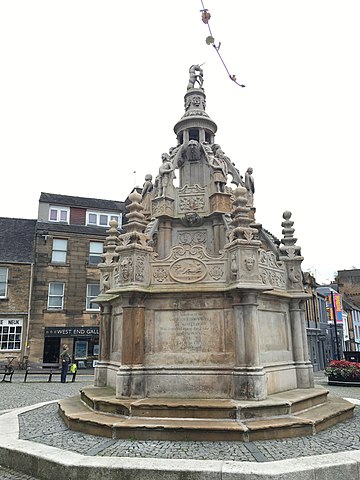Annotation:Cross Well of Edinburgh: Difference between revisions
No edit summary |
No edit summary |
||
| Line 3: | Line 3: | ||
{{TuneAnnotation | {{TuneAnnotation | ||
|f_tune_annotation_title= https://tunearch.org/wiki/Annotation:Cross_Well_of_Edinburgh > | |f_tune_annotation_title= https://tunearch.org/wiki/Annotation:Cross_Well_of_Edinburgh > | ||
|f_annotation=[[File: | |f_annotation=[[File:Crosswell.jpg|thumb|right|400px|Cross Well, Linlithgow]]'''CROSS WELL OF EDINBURGH, THE'''. Scottish, Reel (cut time). D Major. Standard tuning (fiddle). AABBCCD. John Glen (1891) finds the earliest printing of the tune in Robert Bremner's 2nd collection, 1768 (p. 110). The Cross Well, Linlithgow, was originally a spring that had been covered in 1620, a little south of its present location on High Street. It was moved when the market cross was taken away, and in 1807 in was covered by a fountain shaped like an imperial crown, built by one-armed stone mason Robert Gray. | ||
|f_source_for_notated_version= | |f_source_for_notated_version= | ||
|f_printed_sources=Robert Bremner ('''For the year 1769 a collection of scots reels, or country dances'''), p. 110) | |f_printed_sources=Robert Bremner ('''For the year 1769 a collection of scots reels, or country dances'''), p. 110) | ||
Revision as of 17:26, 1 July 2023
X:1 T:Cross well of Edinburgh, The M:C| L:1/8 R:Ree; B:Robert Bremner – “For the year 1769 a collection of scots reels, or country dances” (p. 110) F:https://digital.nls.uk/special-collections-of-printed-music/archive/104994078 Z:AK/Fiddler’s Companion K:D AF (AB/c/ d)ABd|AF (AB/c/ d)F TE2|(AF)AB defd|egTfe d/d/d d2:| |:(f/g/a) (df) a>bTag|(f/g/a) (df) efTed|f/g/a (df) a>bag|fdef d/d/d d2:| |:d2 (FA) dAdf|dAFA dF TE2|d2 FA defd|egTfe d/d/d d2:| (f/g/a) da fdad|(g/a/b) eb gebe|(f/g/a) df a>bTag|fdef d/d/d d2| (f/g/a) (.d.a) fdad|(g/a/b) (.e.b) gebg|afge fdec|AgTfe d/d/d d2||


